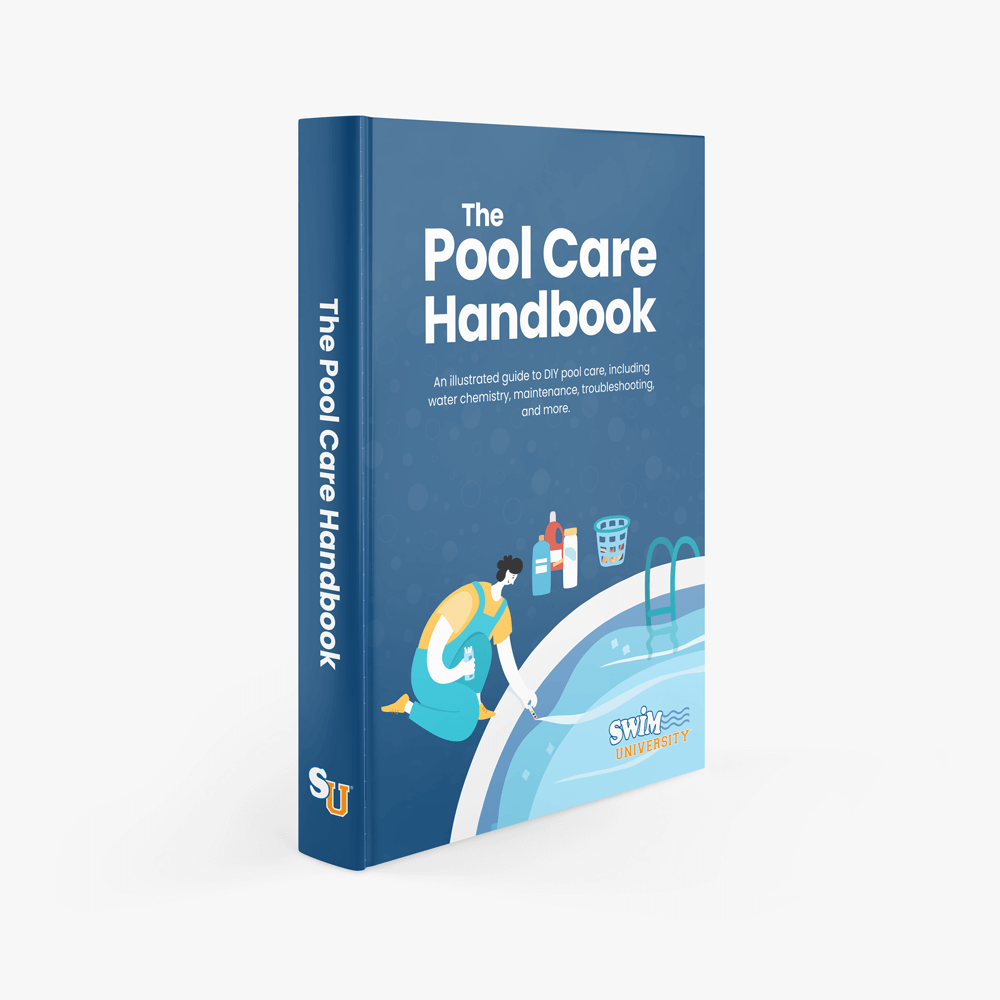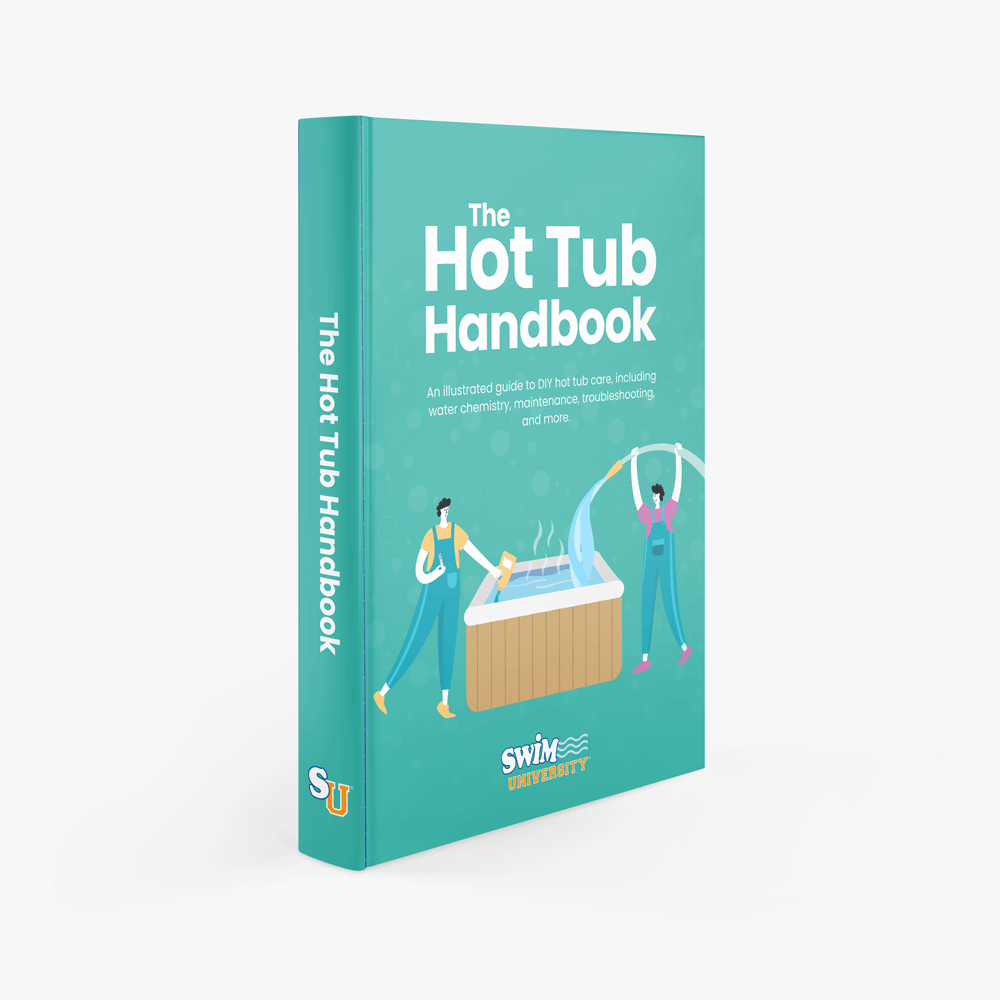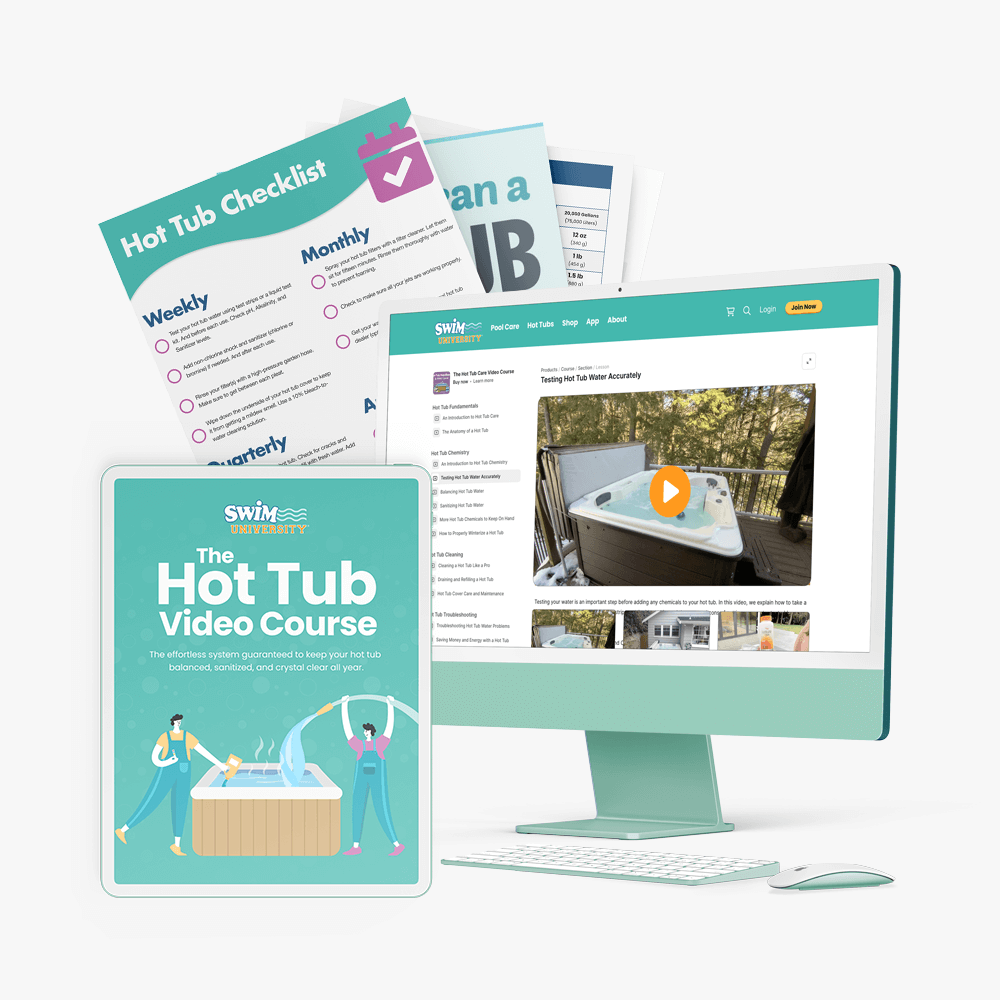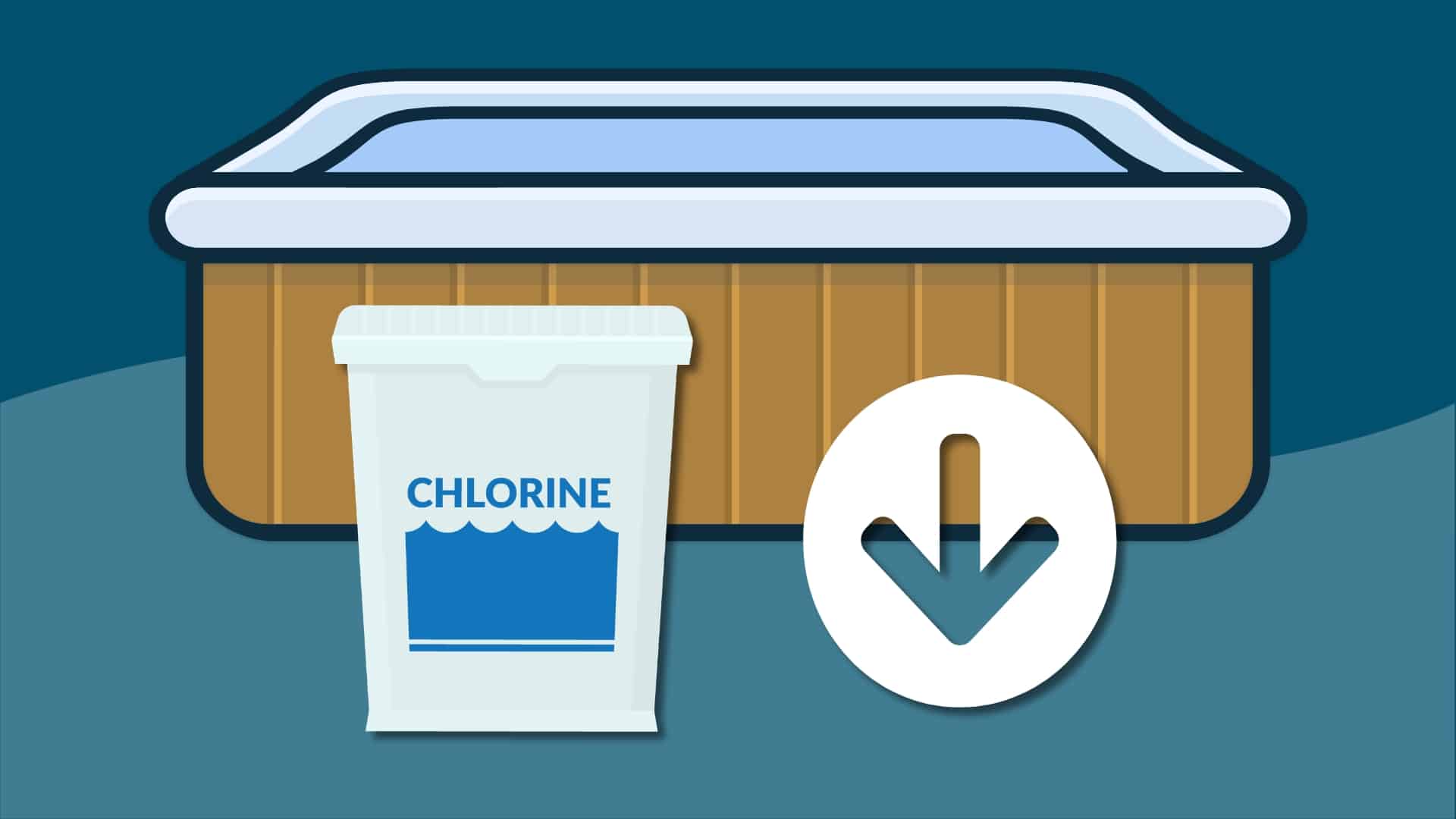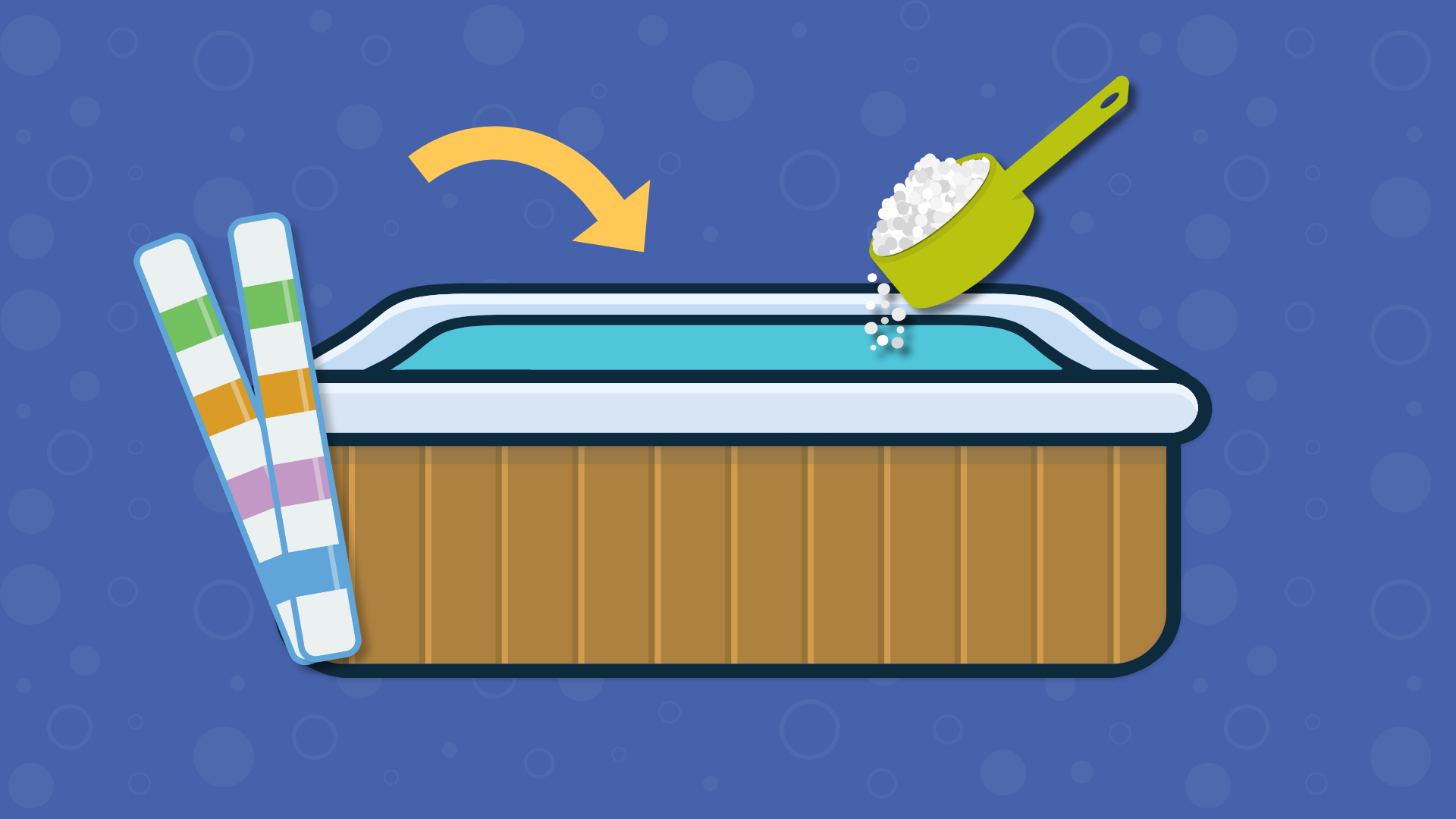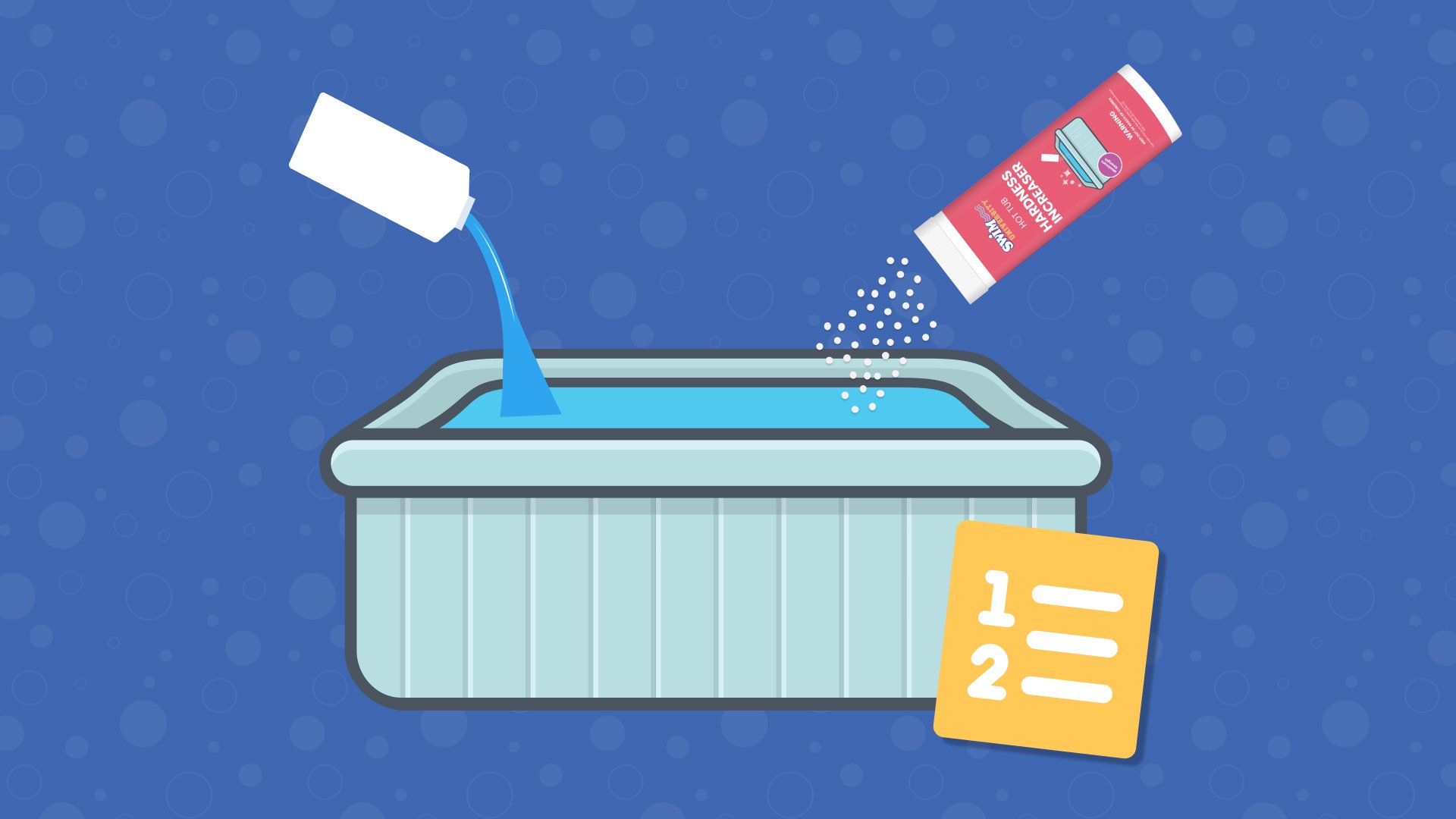The Truth About Owning a Salt Water Hot Tub
If you’re looking to use fewer chemicals and have a gentler soaking experience, switching to a salt water hot tub might be a good idea. And you can convert almost any existing hot tub with a salt water chlorine generator (like this one).
But before buying a salt water system, it’s important to know the difference between that and a traditional hot tub. Plus, know if it’s safe to use in your existing hot tub. In this article, we’ll bust several myths about salt water that every hot tub owner needs to know.
Check out the video below, or keep reading. 👇
A Warning About Salt Water Hot Tubs
If you research, you’ll be confused about the safety of salt water hot tubs. Here’s the truth: salt water hot tubs are perfectly safe to use. But stories are going around salt water can be corrosive. We’ve seen this happen. But this can also happen in a regular chlorine or bromine hot tub.
Before you convert to a salt water tub, check with the manufacturer to make sure this won’t void your hot tub warranty (if you still have one). And make sure you follow this article for all the proper care techniques.
What’s the Difference Between a Salt Water Hot Tub and a Traditional Hot Tub?
A salt water hot tub sanitizes your water by using salt that’s added directly to your water. The salt passes through a salt water chlorinator or chlorine generator that converts salt to chlorine (hypochlorous acid).
That’s right: a salt water hot tub still contains chlorine. Instead of buying, storing, and adding harsh chemicals to your water, you’re adding salt (which can also be harsh – more on that later).
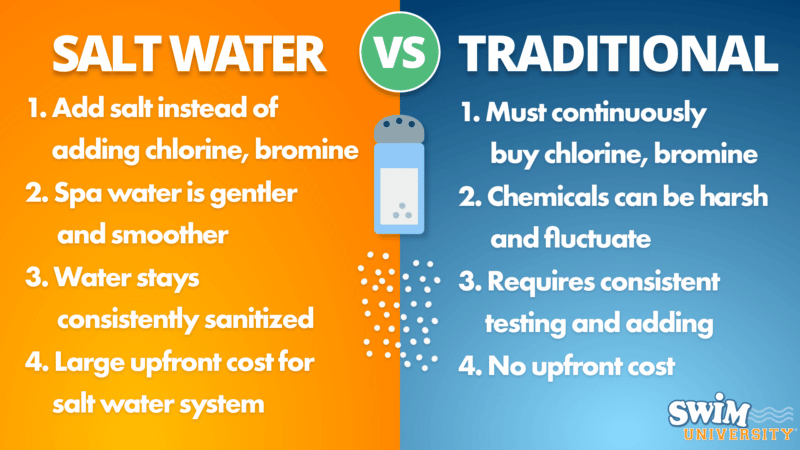
After installing a salt water system, it’s unlikely you’ll even be able to taste the salt in the water. Sea water has a salinity of about 35,000 parts per million (ppm). The recommended salinity level for a salt water hot tub is between 2,000 ppm and 3,000 ppm.
So as long as you add the appropriate amount of salt to your hot tub, and keep your water balanced, the salinity will be undetectable. For a salt water hot tub, you need about 2 1/3 cups of salt per 100 gallons of fresh water. That’s about 11 cups of salt for a 500-gallon hot tub.
Learn how to keep your hot tub clear while saving money so you can enjoy more soaking time without big costs. The Hot Tub Handbook covers every type of hot tub on earth.
How Does Hot Tub Salt Become Chlorine?
A salt water sanitizing system contains a chlorinator cell composed of titanium plates and electrodes. When placed into properly salty water, the chlorinator cell uses a safe amount of electricity to transform the salt into chlorine (hypochlorous acid) via a process called electrolysis. Here’s what a typical saltwater system looks like:
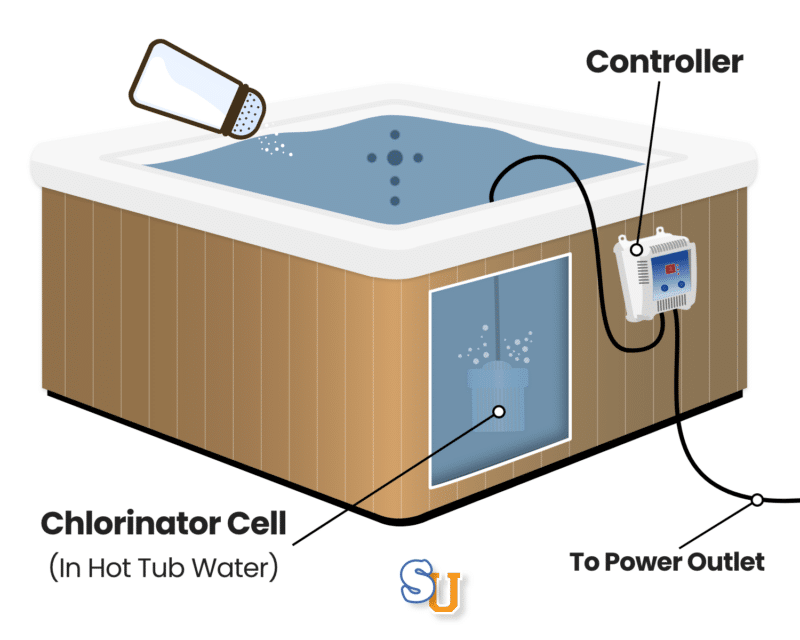
For the generator to work, you’ll need to add pool salt or hot tub salt. If you see it labeled as “pool salt,” that’s perfectly fine to use in your hot tub. This salt is chemically the same thing as table salt, but it’s a coarser grind to work better in a chlorine or bromine generator.
So only add pool-grade or spa-grade salt to your water. If you want bromine in your water, you’ll want to add sodium bromide salts.
Professional Pool Salt crystallizes early to match the fastest dissolve rates on the market - no more waiting for hours for chlorine tablets to dissolve and produce beautiful clean water.
The Benefits of Salt Water Hot Tubs
Switching from other hot tub sanitizing methods has a few big payoffs. A saltwater spa can be less maintenance and a smoother soaking experience. Here are the pros:
1. Consistent Chlorine Levels
Since salt water systems continuously monitor your chlorine levels, they’ll only generate as much natural chlorine as your water needs. That helps prevent extreme fluctuations and helps eliminate that nasty chlorine smell in your water.
2. Gentler Soaking
Chloramines—the chlorine byproducts that can cause burning eyes and breathing difficulty—are reduced in a salt water hot tub. Because the chlorinator is continuously creating a small amount of chlorine, the sanitizer level remains more stable to keep chloramines at bay.
Also, salt water is softer water than traditionally chlorinated water, so it’s easier on the skin, hair, and eyes. And if you use bromine, all of these benefits are increased.
3. Less Time Spent On Maintenance
Salt water spas have a steady concentration of sanitizer being added all the time, so the overall hot tub water chemistry may need less adjusting. And you won’t have to constantly buy, handle and add chlorine or bromine. But regular water care, like testing and balancing pH, is still required.
4. Reduced Cost
Bags of salt are less expensive than chlorine or bromine, plus they’re easier to handle. And after the initial dose of salt, your hot tub’s salinity will stay relatively steady unless it’s diluted with rain or you’ve added fresh water. This means you won’t need to buy salt as often as you would chlorine or bromine.
You’ll still need to test your water on a regular basis to ensure it’s balanced. In addition to using standard test strips you’ll use for pH, alkalinity, etc., you’ll also need to test for salinity every month manually. This is to ensure your salt water generator is reading your levels correctly. You can buy salt water-specific test strips or use a digital salinity reader.
These salt test strips are designed for measuring sodium chloride levels from 400 to 7,000 ppm. They provide accuracy comparable to liquid tests without the hassle of measuring and counting drops.
Salt Water Hot Tub Myths Debunked
Despite the many wonderful benefits of switching to salt, a few myths persist.
1. It Requires No Maintenance Time
All hot tubs require maintenance, no matter what you use to sanitize them. No system is truly “set it and forget it.” Chlorinator cells must be replaced every one to three years. Until then, they need to be cleaned regularly. Typically, cells are cleaned by soaking them in muriatic acid but always defer to the manufacturer’s recommended maintenance for your model.
2. It’s Chemical Free
While you don’t need to buy or add chlorine or bromine to a salt water hot tub, the end result is still water that contains chlorine or bromine. You’ll also still need chemicals like non-chlorine shock and balancing chemicals, such as pH increaser or pH decreaser, to keep your water chemistry balanced.
3. It’s Corrosion Free
Despite its low salinity, the salt water in a hot tub can cause corrosion of metal components. For example, your hot tub’s heating element may not be suited to salt and could corrode quickly if it isn’t a titanium-coated element. Wiping down exposed metals frequently and making sure your water isn’t over-salinated can help prevent corrosion.
What are the Different Types of Salt Water Systems?
The good news is that almost any hot tub can be converted into a salt water hot tub by simply adding a salt chlorine generator.
Before you can convert to a salt water hot tub, you need to decide what kind of salt water chlorinator you want to use: an in-line system or a drop-in. Both use electrolysis to create sanitizer from salt, but have a couple of important differences.
Drop-In Chlorinators
The easiest way to convert to a salt water hot tub is with a drop-in chlorinator. No permanent alterations to the spa are necessary for installation. And setting it up takes minutes. The only drawback is you’ll have a thin cord connected to the chlorinator cell that hangs over the side of your hot tub.
This salt system makes your hot tub clean without adding chemicals by hand. It turns a small amount of salt into chlorine and then back to salt again. Just plug in the controller and put the cell in your tub water. It uses very little power and comes with everything you need to keep your water fresh.
In-Line Chlorinators
If you don’t want a chlorinator line hanging over the side of your hot tub, you can get an in-line salt water conversion kit. This type of chlorinator must be spliced directly into the hot tub plumbing, so the cell becomes part of the spa’s circulation system.
Important: If you’re not an experienced plumber, you may want to hire a pro for in-line installation. Also, these kits may void your hot tub warranty, so check with your spa manufacturer before installing one.
How to Convert to a Salt Water Hot Tub
We’re going to cover how to install a drop-in chlorinator. If you’ve chosen to use an in-line generator, follow the manufacturer’s installation instructions or hire a professional to ensure proper installation. With a drop-in system, it usually takes more work to prepare your hot tub for conversion than it takes to do the actual conversion.
You’ll need:
- Drop-In Salt Water Chlorinator
- Spa Line Flush
- Garden Hose
- Sump Pump (optional)
- Filter Cleaner (or a new filter)
- Hot Tub Surface Cleaner or White Vinegar
- Non-Abrasive Scrub Sponge or Soft Cloth
- Hose Filter
- Salt Water Test Strips
- Hot Tub Salt
- pH Increaser (if needed)
- pH Decreaser (if needed)
- Alkalinity Increaser (if needed)
- Calcium Hardness Increaser (if needed)
- Screwdriver
1. Drain and Clean Your Hot Tub
Before switching from one sanitizing method to another, you must remove all residual sanitizer and any contaminants. Use a spa line flush before you drain and clean the hot tub. This will help clear out biofilm. If you need more help using line flush, be sure to check out our guide on How to Drain and Clean a Hot Tub.
After using the line flush, drain the hot tub with the hose or sump pump. Clean the shell with hot tub cleaner or diluted vinegar and a non-abrasive scrub sponge. Then rinse thoroughly and wash or replace the filter.
2. Refill the Hot Tub
Attach a hose filter to your garden hose to refill your spa with clean, filtered water. The filter helps remove minerals and metals before they get into your spa.
3. Test the Salinity and Add Salt
Before adding anything to the water, test the salinity. Tap water naturally has a small amount of salt in it, so testing first will help you avoid adding too much salt.
Follow the product instructions for adding enough salt to obtain the proper saline level. In general, you need about 2 1/3 cups of salt per 100 gallons of fresh water to reach about 1,750 ppm.
4. Test the Water Chemistry
Test your pH, alkalinity, or calcium hardness and make sure they’re in range based on the recommendations in your chlorinator manual. If anything needs tweaking, adjust it now. And if you need more help with water chemistry, be sure to check out our Hot Tub Chemistry Guide.
You’ll also want to add an initial small dose of chlorine or bromine to the water when starting it up for the first time. Salt system manufacturers recommend this to help your system maintain the proper chlorine or bromine levels. You may need to add an initial dose when you drain and refill your hot tub in the future.
5. Mount the Chlorinator Control Panel
The chlorinator conversion kit should contain a control panel and hardware for mounting it. Place it on the side of your hot tub or a nearby post, making sure the power supply cable will reach your GFCI (ground-fault circuit interrupter) outlet, and the chlorinator cell will reach the spa.
6. Attach All the Cables
Connect the power supply cable and chlorinator cell cord, but do not plug the power cord into an outlet yet.
7. Place the Chlorinator in the Hot Tub
Drape the supply cord over the side of your spa, then place the chlorinator into the deepest part of your hot tub. Putting it as low as possible helps distribute the sanitizer more evenly.
8. Plug in and Start the Generator
Plug the power supply cord into the GFCI outlet. Then turn your chlorinator (or brominator) on. Follow the manufacturer’s instructions to program your generator.
Frequently Asked Questions about Salt Water Hot Tubs
Need more help with salt water hot tubs? Here are several common questions and answers.
How much salt do I need to add to a salt water hot tub?
For a freshly filled hot tub, you need about 2 1/3 cups of salt per 100 gallons of fresh water. That’s about 11 cups of salt for a 500-gallon hot tub. Remember: you can always add more salt, so add it slowly and retest your water. You’ll have to drain out some of your water if you add too much.
What’s the best saltwater hot tub?
Caldera Spas and the Freshwater Salt Systems by Hot Spring Spas both manufacture hot tubs with built-in salt water systems. But you can also buy a salt water system separately and install it on your own.
Can I use any salt in my salt water hot tub?
No, you must use pool-grade or hot tub-grade salt. Salts made for other uses can introduce contaminants and impurities such as heavy metals. Table salt, rock salt, Epsom salt, and even some products marketed as natural, such as pink Himalayan salt, are best left out of your hot tub. Not only can they mess up your water chemistry, but if they damage your spa, there’s a good chance you will have voided the warranty. Make sure you only use salt meant for chlorine (or bromine) generators.
3 Ways We Can Help With Your Hot Tub
- Hot Tub Cheat Sheets (Free): Easy-to-use guides to help you keep your hot tub water balanced and sanitized.
- The Hot Tub Handbook: An illustrated guide to DIY hot tub care, including water chemistry, maintenance, troubleshooting, and more.
- The Hot Tub Care Course. You’ll get step-by-step videos and a step-by-step downloadable guide with everything you need to know about hot tub maintenance.






